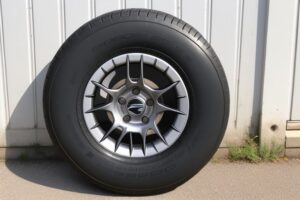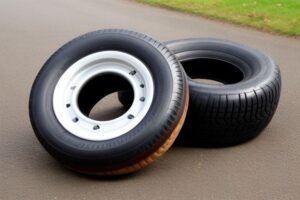How long can you Drive with a Spare Tyre?
Driving with a flat Tyre is not only inconvenient but potentially dangerous. Fortunately, vehicles come equipped with a spare Tyre to help drivers get back on the road quickly. However, many drivers are unsure about how far they can actually drive with a spare Tyre before needing to replace it.
This uncertainty can lead to prolonged use of the spare, which might not be safe. To avoid unnecessary risks, it’s crucial to understand the limitations of driving with a spare Tyre and when it’s time to replace it with a regular Tyre.
Types of Spare Tyres
Before diving into how long you can drive with a spare Tyre, it’s important to recognize that there are different types of spare Tyres. The most common are full-size spares and compact spares (also known as “Doughnuts”). Each type has its own set of guidelines regarding how long and how far you can drive on them.
Full Size Spare Tyre
A full-size spare is identical to your regular Tyres in size and specifications. Because of this, you can drive on it just like any other Tyre, provided it’s in good condition. However, it’s still advisable to get the original Tyre fixed or replaced as soon as possible, as the spare is often not as well-maintained as the regular Tyres.

Compact Spare (Doughnuts)
The compact spare, commonly referred to as a “doughnut,” is smaller and lighter than a full-size Tyre. It’s designed to save space and reduce the vehicle’s overall weight. While convenient, it has significant limitations in terms of speed, distance, and performance. Generally, a donut spare Tyre is intended for temporary use only and should be replaced with a regular Tyre as soon as possible.

How Long Can You Drive with a Compact Spare Tyre?
Driving on a compact spare Tyre is meant to be a temporary solution. Most manufacturers recommend not driving more than 50 to 70 miles on a doughnut spare. This distance is enough to get you to the nearest Tyre shop for a repair or replacement of your damaged Tyre. Prolonged use beyond this recommended range can lead to Tyre failure, which could result in dangerous driving conditions.
Speed Limitations with a Spare Tyre
Another critical factor to consider when driving with a compact spare Tyre is speed. Doughnut spares are not designed for high-speed driving. Most manufacturers recommend not exceeding 50 mph while driving on a compact spare. Exceeding this speed limit can compromise the Tyre’s performance, increase the risk of a blowout, and make the vehicle more difficult to control, especially in adverse weather conditions.
Potential Risks of Driving Too Long on a Spare Tyre
Prolonged use of a spare Tyre, especially a compact spare, can lead to several risks:
-
Reduced Traction: Compact spares usually have less tread than full-size Tyres, which can result in reduced traction, particularly on wet or slippery roads.
-
Imbalanced Handling: Since the spare Tyre is often smaller and lighter, it can cause imbalances in the vehicle’s handling, making it harder to control, especially during sudden maneuvers.
-
Increased Wear and Tear: Driving on a spare Tyre for too long can lead to increased wear on other components of the vehicle, such as the suspension and braking systems.
-
Blowout Risk: Compact spares are not built for long-distance driving or high speeds. The longer you drive on a doughnut spare, the higher the risk of a blowout, which could be catastrophic.
Best Practices When Driving with a Spare Tyre
To ensure your safety and the safety of others on the road, follow these best practices when driving with a spare Tyre:
-
Limit Your Distance: Try not to drive more than 50 to 70 miles on a compact spare Tyre. Use this time to get your original Tyre repaired or replaced as soon as possible.
-
Observe Speed Limits: Do not exceed 50 mph when driving on a doughnuts spare to avoid Tyre failure and maintain control of your vehicle.
-
Check Tyre Pressure: Ensure the spare Tyre is properly inflated before using it. Underinflated Tyres can lead to poor handling and increase the risk of a blowout.
-
Avoid Adverse Conditions: If possible, avoid driving in extreme weather conditions, such as heavy rain or snow, when using a spare Tyre, as it may not provide the same level of performance as a regular Tyre.
How Long Can You Drive with a Full-Size Spare Tyre?
A full-size spare offers more flexibility than a compact spare because it is the same size as your regular Tyres. In theory, you can drive on a full-size spare indefinitely, provided it is in good condition. However, it’s important to note that the full-size spare may not have the same wear and tear as the other Tyres, which could affect vehicle balance and handling over time.
Maintaining Your Spare Tyre
To ensure that your spare Tyre is ready for use when needed, regular maintenance is key. Here are some tips to keep your spare Tyre in optimal condition:
-
Check the Pressure Regularly: Just like your regular Tyres, the spare Tyre should be checked for proper inflation regularly. Underinflated Tyres are prone to blowouts and can be difficult to control.
-
Inspect for Wear and Damage: Periodically inspect the spare Tyre for signs of wear, cracks, or other damage that could compromise its performance.
-
Rotate Your Tyres: If your vehicle comes with a full-size spare, consider rotating it with your regular Tyres during routine maintenance. This helps ensure even wear across all Tyres and extends the life of the spare.
When to Replace Your Spare Tyre
Even if your spare Tyre has never been used, it doesn’t last forever. Tyres degrade over time due to factors like exposure to heat, sunlight, and moisture. Most experts recommend replacing your spare Tyre every six to ten years, regardless of whether it’s been used or not. To determine the age of your Tyre, check the DOT code on the sidewall, which indicates the week and year the Tyre was manufactured.
Why You Shouldn’t Ignore a Damaged Tyre
It can be tempting to continue driving on a spare Tyre, especially if you’re only traveling short distances. However, ignoring a damaged Tyre can have serious consequences. Driving on a compromised spare increases the likelihood of a blowout, which can result in a loss of vehicle control, accidents, or even serious injuries. For this reason, it’s crucial to address a damaged Tyre promptly and replace it with a regular Tyre as soon as possible.
FAQs on How long can you drive with a Spare Tyre?
How long can you drive on a spare Tyre?
You can drive approximately 50 to 70 miles on a compact spare Tyre. A full-size spare, however, can be driven like a regular Tyre, though it’s advisable to replace it as soon as possible.
Can you drive on a spare Tyre on the highway?
It’s possible to drive on the highway with a compact spare, but you should not exceed 50 mph and should limit your distance to 50 to 70 miles. With a full-size spare, you can drive normally, but should still replace it as soon as possible.
What happens if you drive too fast on a spare Tyre?
Driving too fast on a compact spare can lead to a blowout, reduced handling, and increased wear on your vehicle’s suspension and brakes.
How often should you check your spare Tyre?
It’s recommended to check your spare Tyre’s pressure and condition every time you perform routine maintenance on your vehicle, such as oil changes or Tyre rotations.
Can you use a spare Tyre more than once?
A full-size spare can be used multiple times if it is in good condition. However, a compact spare should ideally only be used once and replaced as soon as possible after use.
Is it safe to drive with a spare Tyre in bad weather?
Driving with a spare Tyre in bad weather, especially a compact spare, can be risky due to reduced traction and handling. It’s best to avoid adverse conditions if possible until you can replace the Tyre.
Driving with a spare Tyre is a temporary solution that should be approached with caution. Whether you are using a full-size spare or a compact doughnut, understanding the limitations and risks associated with spare Tyres can help you make informed decisions on the road.
Remember to prioritize safety by replacing your spare Tyre with a regular Tyre as soon as possible, adhering to recommended speed limits, and keeping your spare Tyre well-maintained. By doing so, you’ll ensure that your vehicle remains safe and reliable, no matter the circumstances.
A big thank you for exploring Techlesnar.com! Your visit means a lot to us, and we’re grateful for your time on our platform. If you have any feedback or suggestions, we’d love to hear them.